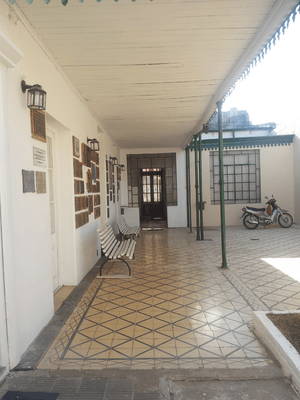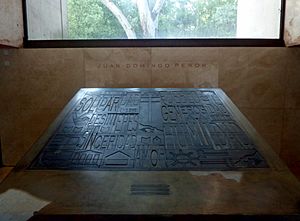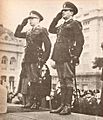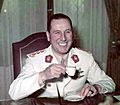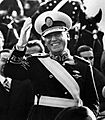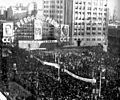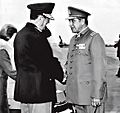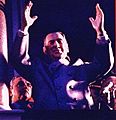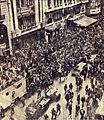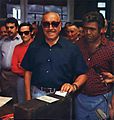Juan Perón facts for kids
Quick facts for kids
Juan Domingo Perón
|
|
|---|---|
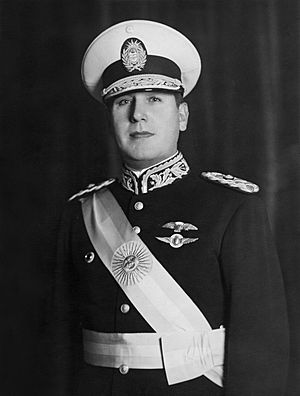
Juan Perón in 1940
|
|
| 29th & 41st President of Argentina | |
| In office 12 October 1973 – 1 July 1974 |
|
| Vice President | Isabel Martínez de Perón |
| Preceded by | Raúl Lastiri |
| Succeeded by | Isabel Martínez de Perón |
| In office 4 June 1946 – 21 September 1955 |
|
| Vice President | Hortensio Quijano Alberto Teisaire |
| Preceded by | Edelmiro Farrell |
| Succeeded by | Eduardo Lonardi |
| Vice President of Argentina De facto |
|
| In office 8 July 1944 – 10 October 1945 |
|
| President | Edelmiro Farrell |
| Preceded by | Edelmiro Farrell |
| Succeeded by | Juan Pistarini |
| Minister of War | |
| In office 24 February 1944 – 10 October 1945 |
|
| President | Pedro Pablo Ramírez Edelmiro Farrell |
| Preceded by | Pedro Pablo Ramírez |
| Succeeded by | Eduardo Ávalos |
| Secretary of Labour and Social Security | |
| In office 1 December 1943 – 10 October 1945 |
|
| President | Pedro Pablo Ramírez Edelmiro Farrell |
| Preceded by | Position established |
| Succeeded by | Domingo Mercante |
| Personal details | |
| Born |
Juan Domingo Perón
8 October 1895 Lobos, Buenos Aires, Argentina |
| Died | 1 July 1974 (aged 78) Olivos, Buenos Aires, Argentina |
| Political party | Labour (1945–1947) Justicialist (1947–1974) |
| Spouses |
Aurelia Tizón
(m. 1929; |
| Signature |  |
| Military service | |
| Allegiance | |
| Branch/service | |
| Years of service | 1913–1945 |
| Rank | |
Juan Domingo Perón (born October 8, 1895 – died July 1, 1974) was an important Argentine Army general and politician. He served as President of Argentina three times. His first time was from June 1946 to September 1955. He was then elected again in October 1973 and served until his death in July 1974.
During his first time as president, from 1946 to 1952, Perón was very popular. He had strong support from his second wife, Eva Duarte, often called "Evita." They were both loved by many people in Argentina.
After Eva passed away in 1952, Perón was elected for a second term. He served until 1955, when he was removed from power. During the years that followed, his political party, known as Peronism, was not allowed, and Perón had to live outside Argentina.
In 1973, Hector Cámpora became president, which allowed Perón to return home. Soon after, Perón was elected president for a third time. His third wife, María Estela Martínez (Isabel Perón), became Vice President. When Juan Perón died in 1974, she became president.
Juan and Evita Perón are still seen as very important figures by their followers, called Peronists. Many people admired their efforts to help people escape poverty and to make work more respected. The political ideas they started are known as Peronism. Today, the Justicialist Party mainly represents these ideas in Argentina. Peronism is seen more as a big political movement than a traditional party because many different kinds of people support it.
Contents
Juan Perón's Early Life and Military Career
Juan Domingo Perón was born in Lobos, a town in Buenos Aires Province, Argentina. In 1904, when he was nine years old, Juan went to a boarding school in Buenos Aires. His grandmother ran the school, and he had a strict Catholic education there.
When he was 16, in 1911, he joined the National Military College. He finished his studies there in 1913. Perón began his military career in the Infantry in Paraná, Entre Ríos. He later became the commander of that post.
He also became an instructor at the Superior War School. In 1929, he was appointed to the Army General Staff Headquarters. From 1936 to 1938, he worked as a military attaché at the Argentine Embassy in Chile.
In 1939, the War Ministry sent Perón to study mountain warfare in the Italian Alps. He also spent a semester at the University of Turin and observed military activities in other European countries. He studied different governments of that time, including Benito Mussolini's Italian Fascism and Nazi Germany. He returned to Argentina in 1941 and worked as an Army skiing instructor in Mendoza Province.
Eva Perón's Important Work and Influence
Eva Perón was a very important person and a symbol of hope for working people during Argentina's first "five-year plan." When she passed away in 1952, the same year as the presidential elections, many people felt they had lost a true friend.
Eva came from a humble background. While some wealthy people disliked her, the poor loved her for her work helping the sick, the elderly, and orphans. Because of her efforts, women in Argentina gained the right to vote in 1947. She also helped create a women's group within the political party that focused on the rights of women, the poor, and people with disabilities.
In 1948, Eva started the Eva Perón Foundation. This foundation was a huge help to her husband's social plans. It had 14,000 employees and built many new schools, clinics, homes for the elderly, and places for people to go on holiday. The foundation also gave out many household items, arranged doctor visits, and offered scholarships.
Some of the most famous projects built by the Foundation include the Evita City development near Buenos Aires, which had 25,000 homes. Another well-known project was the "Republic of the Children," a fun theme park based on classic fairy tales.
Eva's influence was key to many of Perón's policies during his first term. These included plans for full employment, public healthcare, housing, benefits for workers, and pay raises. Her focus on helping people in need, especially the working class, made the Peronist movement very popular with ordinary Argentines.
Juan Perón's Final Years
Juan Perón passed away on July 1, 1974, in Buenos Aires. His wife, Isabel, continued as president until a military takeover led by General Jorge Videla removed her from power on March 24, 1976.
Perón was first buried in La Chacarita Cemetery in Buenos Aires. Later, on October 17, 2006, his remains were moved to a special mausoleum at his old summer home. This home was rebuilt as a museum in San Vicente, a suburb of Buenos Aires.
Images for kids
-
President Edelmiro Farrell (left) and his benefactor, Vice President and Colonel Juan Perón, in April 1945.
-
Reservoir of the Valle Grande hydroelectric dam, near San Rafael, Mendoza
-
A hospital near Rosario, one of hundreds built during the Perón years
-
Golda Meir talks with Evita Perón on Meir's visit to Argentina, 1951.
-
Perón greeting Augusto Pinochet at Morón Airbase on 14 May 1974.
-
The new leader, General Eduardo Lonardi, waves in a 1955 newsmagazine cover. His gradualist approach to "de-Perónization" led to his prompt ousting.
-
Student unrest in Rosario, 1969 (the Rosariazo). Unable to return on his volition, Perón began rallying besieged leftist students (the very people he had repressed in office).
-
Juan and Isabel Perón with Nicolae and Elena Ceaușescu during their state visit to Argentina on 6 March 1974.
See also
 In Spanish: Juan Domingo Perón para niños
In Spanish: Juan Domingo Perón para niños


